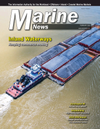
Page 51: of Marine News Magazine (February 2020)
Pushboats,Tugs & Assist Vessels
Read this page in Pdf, Flash or Html5 edition of February 2020 Marine News Magazine
On occasion, the facility has been used to blast structural components and assemblies for C&C projects.” “With all the system modi? cations, our capacity has nearly doubled,” Cibilich says.
The site is currently operated by a staff of 16 with the capacity to operate 24 hours a day. About 90% of the work is repair, but all barges newly constructed by C&C are blasted in the new facility.
Cibilich says the steel grit media used onsite provides a superior pro? le ? nish over conventional media, resulting in improved paint adhesion to steel with fewer required paint jobs during the life of the barge.
“The paint facility can perform a full range of marine coatings and applications, including anti-fouling, epoxy, non-skid deck application and any customer-supplied speci? cation and applications,” Cibilich says. “And due to our superior blasting and painting processes, C&C is cur- rently in discussions with paint manufacturers to guaran- tee their coatings for a to-year period.”
Being able to work indoors provides a number of ben- e? ts – for customers, the environment and the yard itself.
“The indoor facility prevents overspray, contamination and runoff of paint and blast media into adjacent water- ways. The facility’s state-of-the-art air ? ltration system col- lects and encapsulates over 99% of all airborne particulates associated with the blast and paint process. The nontoxic steel shot blast media can be ? ltered, separated and reused approximately 150 times over in subsequent blasting op- quickly realized there was an opportunity to adapt this erations, reducing waste typically sent to land? lls.” technology for the barge industry,” Cibilich recalls. “We “Because we are operating in a controlled environment, were determined to create a process of blasting and paint- overspray is minimal. We estimate that we reduce paint ing barges that would be better for the environment, safer consumption by 20%, a cost savings recouped directly by for our employees and more ef? cient.” the customer as they typically provide the paint. Addition-
Cibilich says C&C created the conceptual design (patent ally, the controlled environment of our fully enclosed facil- pending) and worked with Blastman to design and build ity allows us to spray a single coat over the entire barge as the site’s custom, state-of-the-art mobile blasting unit.
opposed to spraying in sections as is typically done when “The robotic blasting process consists of an upper sys- painting outside.” tem and a lower system, that can work simultaneously
Another bene? t is a safer work environment for employ- or independently. Although the upper robots employed ees. “During the blasting process, operators oversee and
Blastman’s typical blast technology, our system was twice control operations safely from a segregated air-conditioned the size of anything Blastman had ever built. The bottom control room. Additionally, by eliminating the need to robot became the more challenging system because the erect scaffolding to perform blasting operations, the dan- technology to blast the bottom of barges was nonexistent.” gers associated with manually operating a blasting hose at
The facility was designed and built speci? cally to per- multiple elevations are eliminated.” form blast and paint jobs for the marine industry, includ-
And by taking projects indoors and out of the ele- ing hopper, tank and deck barges, Cibilich says, but adds, ments, the facility helps to keep C&C Marine’s projects “We can blast virtually anything subject to size constraints. running smoothly and on schedule. “The facility is un- 51 www.marinelink.com MN

 50
50

 52
52
